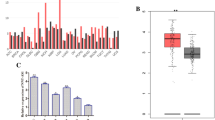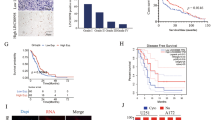Abstract
Long non-coding RNAs (lncRNAs) are closely associated with tumorigenesis of various malignancies, including glioma. However, the roles of most lncRNAs in glioma remain undiscovered. The present study for the first time explored the roles of NFIA-AS2 in glioma. Based on informatic analyses by online database, lncRNA NFIA-AS2 in glioma tissues was overexpressed and further confirmed in glioma tissues and cells by quantitative real-time PCR (qRT-PCR). High expression of NFIA-AS2 was closely correlated with poor prognosis and might be an independent prognostic factor for PFS and OS. Functionally, silenced NFIA-AS2 could remarkably hinder glioma cell proliferation, migration and invasion, and cause the apoptosis. Mechanistic investigation disclosed that NFIA-AS2 interacted with miR-655-3p and inversely connected with miR-655-3p in glioma. Additionally, miR-655-3p was proved to regulate the expression of ZFX. Final rescue assay demonstrated that ZFX overexpression or miR-655-3p downregulation could neutralize the suppressive effects of NFIA-AS2 knockdown on glioma progression. In conclusion, this study firstly reported that NFIA-AS2 could promote the progression of glioma by targeting the miR-665-3p/ZFX axis, which highlighted that NFIA-AS2 could be a novel biomarker and therapeutic target for glioma patients.




Similar content being viewed by others
References
Siegel RL, Miller KD, Jemal A. Cancer statistics, 2016. CA Cancer J Clinicians. 2016;66(1):7–30.
Hanif F, Muzaffar K, Perveen K, Malhi SM, Simjee ShU. Glioblastoma multiforme: a review of its epidemiology and pathogenesis through clinical presentation and treatment. Asian Pac J Cancer Prev. 2017;18(1):3–9.
Bahadur S, Sahu AK, Baghel P, Saha S. Current promising treatment strategy for glioblastoma multiform: a review. Oncol Rev. 2019;13(2):417.
Wilusz JE, Sunwoo H, Spector DL. Long noncoding RNAs: functional surprises from the RNA world. Genes Dev. 2009;23(13):1494–504.
Evans JR, Feng FY, Chinnaiyan AM. The bright side of dark matter: lncRNAs in cancer. J Clin Investig. 2016;126(8):2775–822.
Huarte M. The emerging role of lncRNAs in cancer. Nat Med. 2015;21(11):1253–61.
Hu X, Sood AK, Dang CV, Zhang L. The role of long noncoding RNAs in cancer: the dark matter matters. Curr Opin Genet Dev. 2017;48:8–15.
Xin Y, Zhang W, Mao C, Li J, Liu X, Zhao J, et al. LncRNA LINC01140 inhibits glioma cell migration and invasion via modulation of miR-199a-3p/ZHX1 axis. Onco Targets Ther. 2020;13:1833–44.
Gu N, Wang X, Di Z, Xiong J, Ma Y, Yan Y, et al. Silencing lncRNA FOXD2-AS1 inhibits proliferation, migration, invasion and drug resistance of drug-resistant glioma cells and promotes their apoptosis via microRNA-98-5p/CPEB4 axis. Aging (Albany, NY). 2019;11(22):10266–83.
Huang D, Wang Y, Xu L, Chen L, Cheng M, Shi W, et al. GLI2 promotes cell proliferation and migration through transcriptional activation of ARHGEF16 in human glioma cells. J Exp Clin Cancer Res. 2018;37(1):247.
Xiao Y, Zhu Z, Li J, Yao J, Jiang H, Ran R, et al. Expression and prognostic value of long non-coding RNA H19 in glioma via integrated bioinformatics analyses. Aging (Albany, NY). 2020;12(4):3407–30.
Jia P, Cai H, Liu X, Chen J, Ma J, Wang P, et al. Long non-coding RNA H19 regulates glioma angiogenesis and the biological behavior of glioma-associated endothelial cells by inhibiting microRNA-29a. Cancer Lett. 2016;381(2):359–69.
Fu C, Li D, Zhang X, Liu N, Chi G, Jin X. LncRNA PVT1 facilitates tumorigenesis and progression of glioma via regulation of MiR-128-3p/GREM1 axis and BMP signaling pathway. Neurotherapeutics. 2018;15(4):1139–57.
Xue W, Chen J, Liu X, Gong W, Zheng J, Guo X, et al. PVT1 regulates the malignant behaviors of human glioma cells by targeting miR-190a-5p and miR-488-3p. Biochim Biophys Acta Mol Basis Dis. 2018;1864(5 Pt A):1783–94.
Yang A, Wang H, Yang X. Long non-coding RNA PVT1 indicates a poor prognosis of glioma and promotes cell proliferation and invasion via target EZH2. Biosci Rep. 2017;37(6):BSR20170871.
Gao YF, Liu JY, Mao XY, He ZW, Zhu T, Wang ZB, et al. LncRNA FOXD1-AS1 acts as a potential oncogenic biomarker in glioma. CNS Neurosci Ther. 2020;26(1):66–75.
Zhao XQ, Liang B, Jiang K, Zhang HY. Down-regulation of miR-655-3p predicts worse clinical outcome in patients suffering from hepatocellular carcinoma. Eur Rev Med Pharmacol Sci. 2017;21(4):748–52.
Wu G, Zheng K, Xia S, Wang Y, Meng X, Qin X, et al. MicroRNA-655-3p functions as a tumor suppressor by regulating ADAM10 and beta-catenin pathway in hepatocellular carcinoma. J Exp Clin Cancer Res. 2016;35(1):89.
Wang W, Cao R, Su W, Li Y, Yan H. miR-655-3p inhibits cell migration and invasion by targeting pituitary tumor-transforming 1 in non-small cell lung cancer. Biosci Biotechnol Biochem. 2019;83(9):1703–8.
Zha JF, Chen DX. MiR-655-3p inhibited proliferation and migration of ovarian cancer cells by targeting RAB1A. Eur Rev Med Pharmacol Sci. 2019;23(9):3627–34.
Zhu Z, Li K, Xu D, Liu Y, Tang H, Xie Q, et al. ZFX regulates glioma cell proliferation and survival in vitro and in vivo. J Neurooncol. 2013;112(1):17–25.
Zhou Y, Su Z, Huang Y, Sun T, Chen S, Wu T, et al. The Zfx gene is expressed in human gliomas and is important in the proliferation and apoptosis of the human malignant glioma cell line U251. J Exp Clin Cancer Res. 2011;30:114.
Author information
Authors and Affiliations
Contributions
L-QT designed the experiments, analyzed data and wrote the manuscript. JX and L-HZ completed the experiments, collected the data and revised the manuscript. X-YZ collected the data and analyzed data. All authors approved the submission and were responsible for the authenticity of this manuscript.
Corresponding author
Ethics declarations
Conflict of interest
The author(s) declare that they have no competing interests.
Ethical standards
This research was approved by the Ethics Committee of Linyi People’s Hospital.
Informed consent
Informed consent was obtained from all individual participants included in the study.
Additional information
Publisher's Note
Springer Nature remains neutral with regard to jurisdictional claims in published maps and institutional affiliations.
Rights and permissions
About this article
Cite this article
Xin, J., Zhao, YH., Zhang, XY. et al. LncRNA NFIA-AS2 promotes glioma progression through modulating the miR-655-3p/ZFX axis. Human Cell 33, 1273–1280 (2020). https://doi.org/10.1007/s13577-020-00408-9
Received:
Accepted:
Published:
Issue Date:
DOI: https://doi.org/10.1007/s13577-020-00408-9




